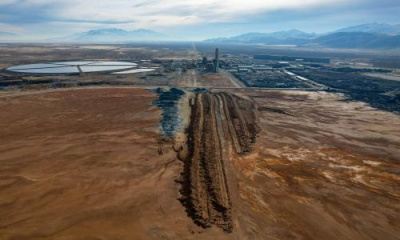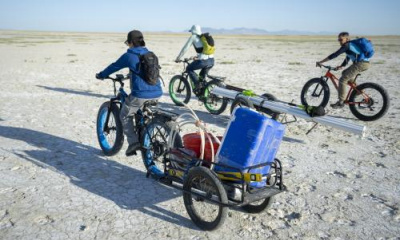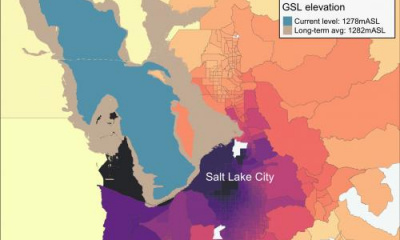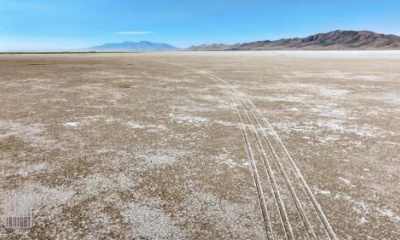Dust from the Great Salt Lake's exposed lakebed would distinctly impact residents on the west side of Salt Lake City and in Tooele County, per a recent NASA DEVELOP technical report.
Driving the news: After years of drought and excessive water use, experts say the Great Salt Lake "as we know it" is projected to disappear by 2027, unless there's a surge in water flow, according to a separate report released in January.
- That would require slashing one-third to half of consumptive water use in the Great Salt Lake watershed, per the report.
Of note: Experts estimated this year's record snowpack added another two years to the Great Salt Lake's environmental outlook, per KSL.com.
Context: Historically red-lined communities west of Salt Lake City have long encountered poor air quality from nearby pollutants, including freeways, refineries, trains, and the growing Salt Lake City International Airport.
- West side neighborhoods also face higher asthma rates and health risks associated with pollution compared to the east side, according to findings from an Environmental Protection Agency preliminary report released this month that focused on six west side neighborhoods.
What they're saying: Increased high dust events could exacerbate poor air quality west of the Salt Lake Valley, potentially leading to worse health outcomes, said Daniel Mendoza, a research assistant professor of atmospheric sciences at the University of Utah.
- Mendoza said he recently heard a resident describe west side communities as human "air purifiers" because they're the first to inhale pollutants from the West Coast, such as wildfire smoke.
- "While the lake might be a new element to this problem, these communities have been talking about pollution exposure for a very long time," said Piper Christian, project lead of the technical report.
Between the lines: Salt Lake City Councilmember Alejandro Puy said cleaner air is important to west side residents, but many are juggling more immediate priorities like working multiple jobs or putting food on the table.
And moving out of the area isn't an option.
- "Many of the families on the west side won't have the luxury of escaping," said Puy, whose district represents Glendale, Poplar Grove, and parts of Fair Park. "Those with wealth will be able to escape and those that don't, won't. We need to stop that before it happens."
- Shawnya Wayman, owner of Hide Out Farm and Ranch in Erda, Utah, who grows produce and raises cows, said dust storms have become so frequent and powerful they've ruined her crops.
- "We put a lot of time and a lot of love into this place. And so to walk away from it would be devastating."
Zoom in: Terry Marasco, a member of the advocacy group Westside Coalition, said he regularly runs and bikes around his neighborhood unless the air quality is too unhealthy.
- "When I see that it's a 'red' air day, I have to wear a mask or not run [and] go to the gym instead. I have to worry about health problems."
The latest: In May, the EPA awarded Salt Lake City $1 million to improve air quality.
- The funding came months after the EPA launched an environmental justice study focused on Salt Lake City's west side.
- The study is set to be published later this month.
The bottom line: Marasco said he welcomes the increased federal attention on environmental inequities that exist on the west side.
- "We're poised to make some noise about it," he said. "We're not going to be silent, that's for sure."
FOX 13's Jenna Bree contributed to this report. This article originates from the Great Salt Lake Collaborative, a solutions journalism initiative designed to inform people about the plight of the Great Salt Lake.








